


To advocate and create a strong atmosphere of "reading books, reading good books, and reading more books," and to encourage employees to "apply what they learn," DKEC Chemical Group provided its employees with seven good books in 2020. The book list is as follows:
1. "Focus" by Jurgen Wolff
2. "Not Good at Communicating, You Could Never Be a Remarkable Manager" by Ye Zhou
3. "The Power of Habit" by Charles Duhigg
4. "Reliable" by Tetsuyuki Oishi
5. "Influence" by Robert B. Cialdini
6. "Atomic Habits" by James Clear
7. "The 7 Habits of Highly Effective People" by Stephen Covey
As the saying goes, "Reading ten thousand books is equivalent to traveling ten thousand miles." Exploring in books and practicing in reality are important means of self-improvement. In the context of the normalization of the epidemic in 2020, when it was difficult to travel far, we could still explore a new world through reading ten thousand books. The employees actively participated in the reading activities and selected the book that resonated with them the most from the book list, sharing their insights and experiences with each other. Below, we have selected some excellent excerpts to share with everyone.
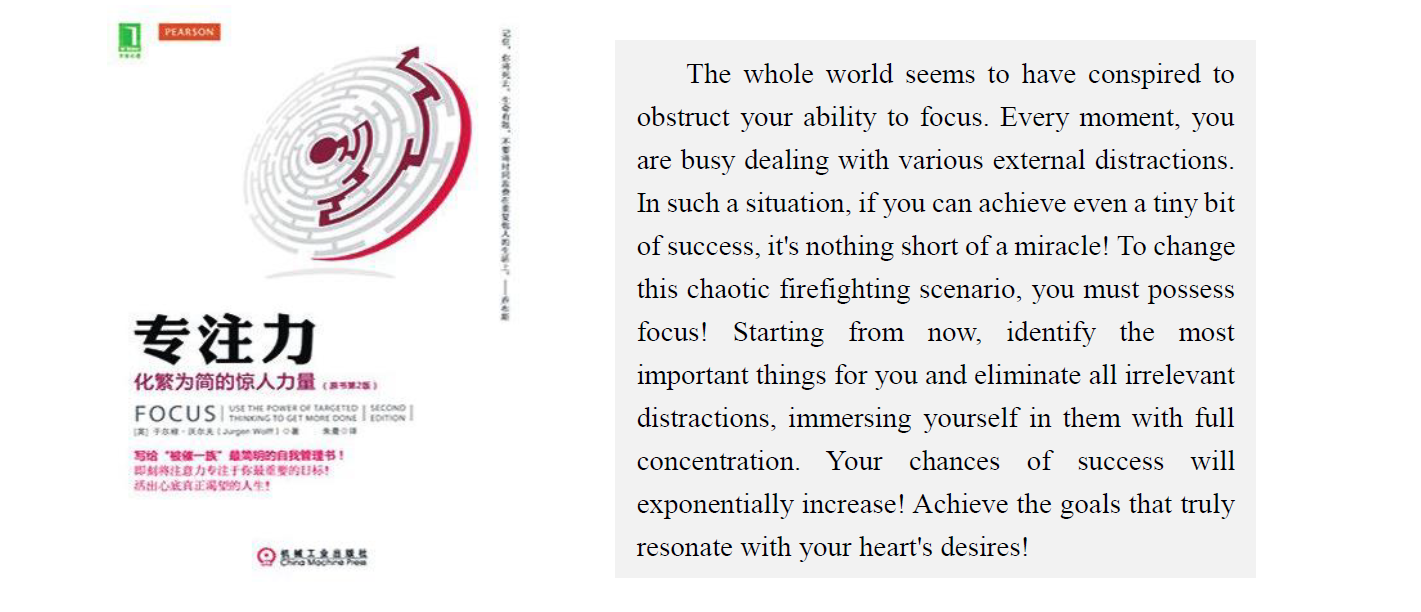
As we age and gain more experiences, we find that our minds become occupied with an increasing number of things, making it more difficult to focus on one thing or sustain concentration for a prolonged period. However, those with strong willpower can overcome distractions and stay focused on achieving their goals, thus reaching new heights. This realization has made me aware that focus is the greatest difference between mediocrity and success.
Now that I have entered the workforce and look back on my experiences over the years, I realize that focus has played a significant role in my life. During my academic years, it goes without saying that I was fully attentive during classes, and when conducting scientific research, I was immersed in the scenarios of experiments and simulations as if they were right in front of me. Even now, at my current job, there are times when I become so engrossed in my work that I finish eating without even realizing it. However, I am gradually starting to feel the loss of focus. It seems that I can no longer concentrate for as long as I used to, and I easily become restless after a certain period of focus. Furthermore, it is much easier to focus on one thing than to focus on multiple things simultaneously, but the reality is that encountering multiple tasks at the same time is unavoidable. Currently, the company is facing the challenge of simultaneously completing multiple projects as we navigate the normalized state of the pandemic. The number of projects and overall performance have seen significant growth. This undoubtedly poses a greater challenge, but this book has provided me with some insights and guidance.
Firstly, setting deadlines for myself and utilizing the panic of not being able to meet them as motivation to stay focused on the tasks at hand. Secondly, creating a "goal map" that outlines the time required to achieve each step, and making proper use of a schedule planner. Lastly, saying goodbye to procrastination by quickly completing tasks that can be done swiftly, freeing up energy to tackle other work. With determination and proper planning, everyone can effectively handle multiple tasks with ease.
In my work, there are often complex tasks that cannot be completed in a short time (such as long-term website development and organizing the printing of large-scale project blueprints), as well as trivial tasks that can arise at any time (such as email correspondence and printing simple documents). I often find myself in a situation where I'm working on task A and get a phone call notifying me about task B.In such cases, I am likely to do one of the following:
1) continue working on task A and then forget about task B after completing A, only to remember it much later;
or 2) immediately switch to task B and then come back to task A, but having to reorient myself to its requirements. Both approaches are not very effective.
As a result, I started writing down all the tasks on paper. If it's a large project, I break it down into subtasks and write them down. If it's several small tasks, I list them one by one. I quickly assess the urgency and importance of each task and prioritize them accordingly. If a new task arises while I'm in the middle of working on something, I write it down as well. After completing one task, I assess what the next one should be.
In practice, besides taking a little time to write a few words, this approach actually improves my overall focus. I don't need to think about tasks B, C, and D while I'm doing task A. Instead, I focus on completing one task and then move on to the next. I often say that tasks should be done one by one. If I pile up all the tasks for the day in front of me, I naturally won't feel motivated to start. However, by breaking them down into smaller tasks and tackling them one by one, focusing on one task at a time during a specific time period, the work becomes much more manageable.
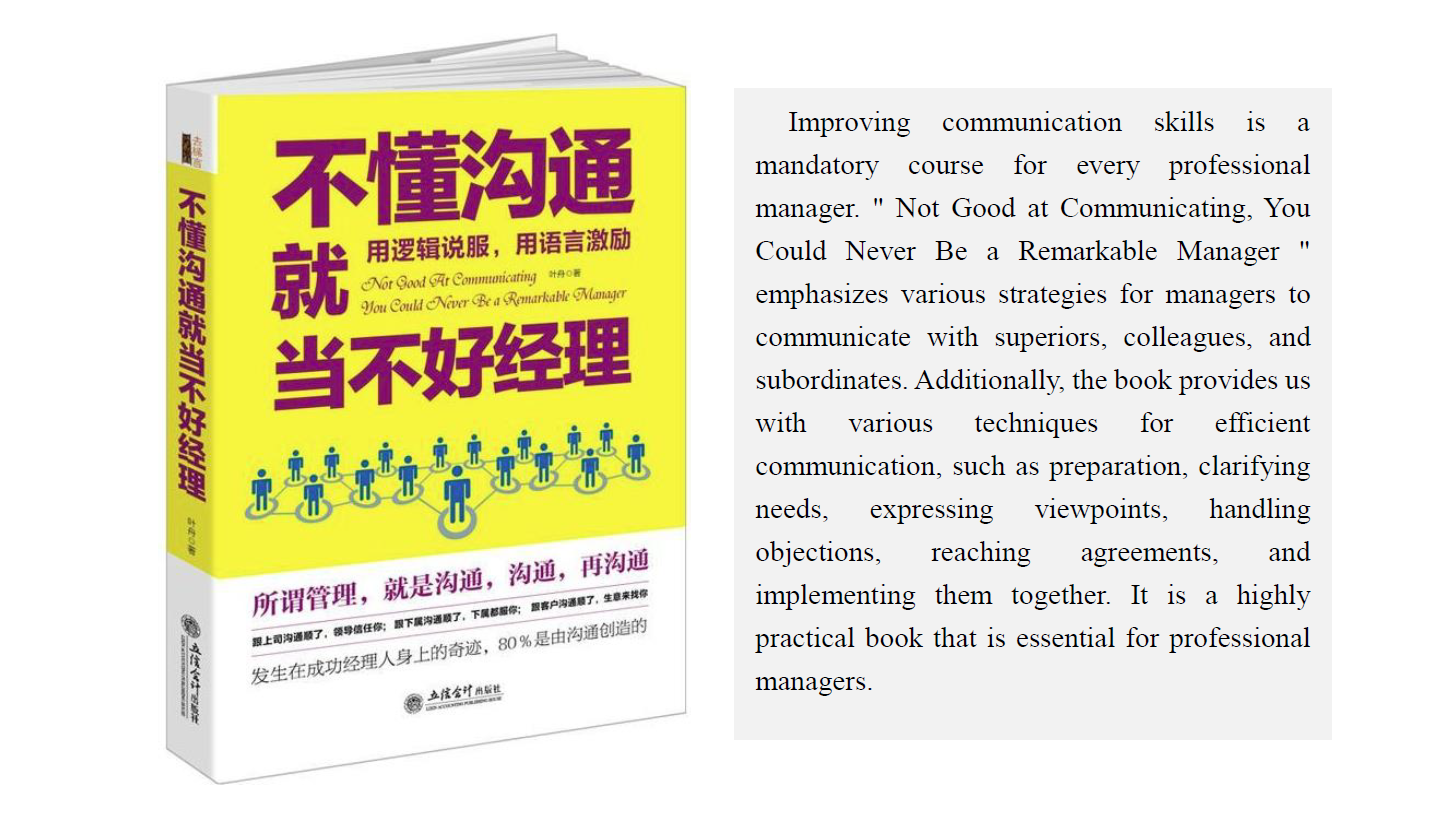
To achieve effective communication with others, it is essential to adjust one's emotions, maintain a positive mindset, and possess a sunny disposition. People who are friendly and approachable tend to create a comfortable atmosphere, making communication with them easier and more enjoyable.
Communication is not merely about transmitting information, conveying voices, and displaying behavior; it should prioritize the exchange of thoughts and emotions. In other words, communication should be heartfelt. Communication that lacks thoughtful consideration of ideas and emotions cannot be deemed as effective. Similarly, if one does not invest enough effort in communication, the intended purpose of communication cannot be achieved.
Furthermore, communication requires attention to methods and artistry. For example, communication may not yield favorable results in inappropriate timing or unsuitable settings. Similarly, using the same communication approach with different individuals is not effective. Employing different communication strategies tailored to different individuals allows for targeted and effective communication.
![]()
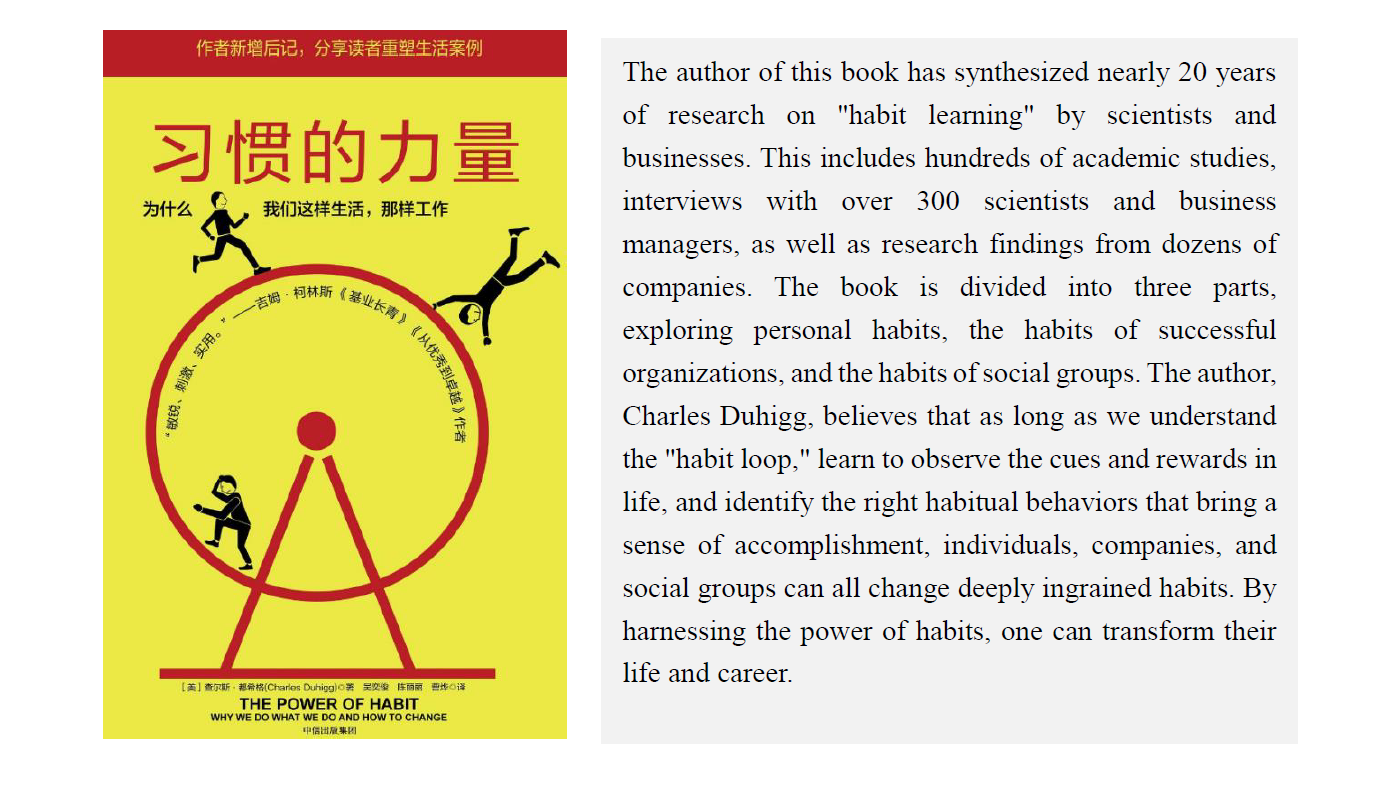
Be the master of your habits, not a servant to them.
A person's greatest enemy is oneself, and changing bad habits is a process of overcoming and conquering oneself. Procrastination and compromise are common bad habits in life and work. For me, it is necessary to cultivate the habit of taking action and persisting in everything.
Habits are a part of instinct. By repeating the same actions, the impression of these behaviors deepens in the brain. The more stimuli, the deeper the impression. For bad habits, it is important to change the objective environment and prevent them from thriving in their conducive conditions. The start of a habit can be a small step, but that small step must be persisted in. In life and work, it is crucial to take firm steps and cultivate good habits. As a process designer and project manager, it is necessary to provide information to other professionals and communicate with them effectively. Developing good habits is even more important as it facilitates better work. Once good habits are formed, it becomes easier to implement plans and take action. Without proactive action, success is not possible.
Looking back at the difficulties and doubts I have encountered along the way, they were not as challenging as I imagined. It was simply because I didn't have good habits, and many strange ideas would arise out of nowhere. Habitual behavior can be described as more rational than emotional. When you follow this pattern in your actions, it becomes a subconscious part of you. There's no need to overcome multiple difficulties because once you complete an action governed by this habit, it becomes a reward for yourself. In future work, we should all develop our own core habits. For example, as mentioned in the quarterly OKRs of the company, how much time do you spend on deep work each day? From this perspective alone, it's worth pondering. Have you truly met the requirements for dedicating sufficient time to design every day? How much have your colleagues achieved, and how much have you achieved? If there are gaps, have you genuinely reflected on the reasons behind them? In your daily work moving forward, how much time do you demand of yourself to be fully engaged, and how will you eliminate distractions? As someone who has just entered this industry, clarifying these questions and gradually developing a habit of dedicating at least 4 hours to deep work every day, I believe I can make rapid progress and improvement.
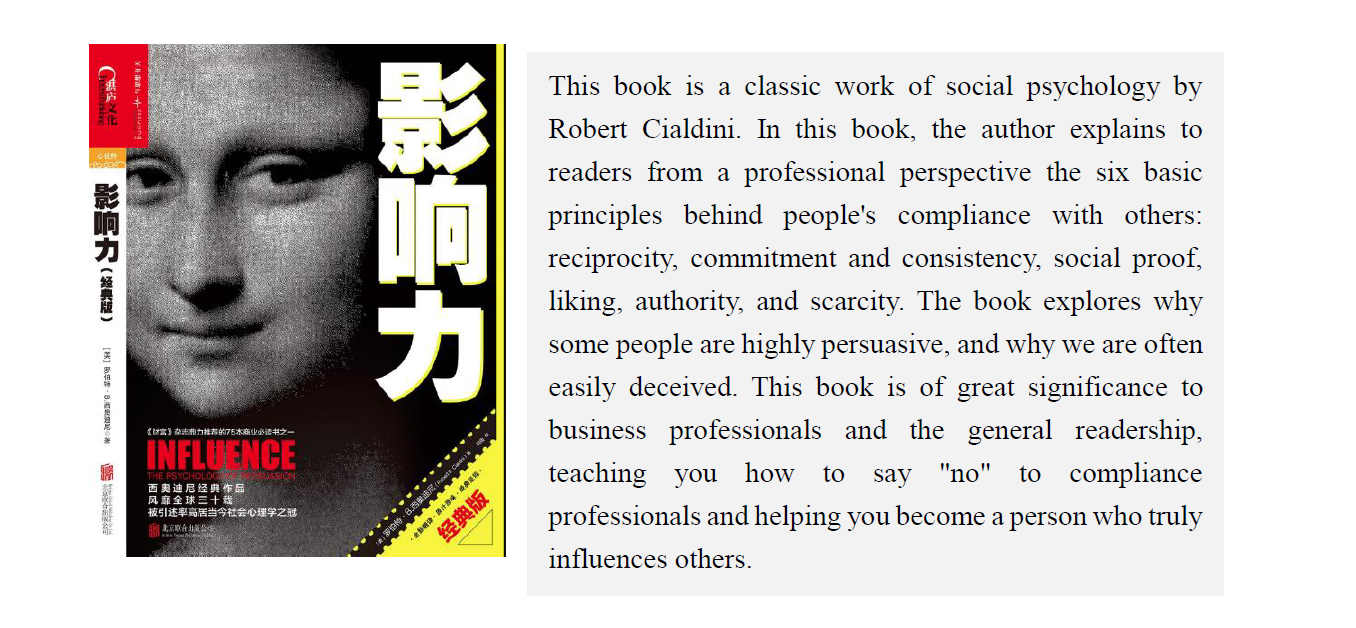
After reading this book, the biggest realization is that behind seemingly ordinary phenomena, behaviors, and rational responses, there are actually many psychological elements at play.
This book analyzes the fascinating psychology behind various behaviors using scientific theories, using vivid examples that we often encounter in daily life. Psychology takes human experiences as a key research subject and focuses on the various psychological motivations that arise from these experiences, influencing human judgments and behaviors towards events. It's like a weight in the brain, measuring and then influencing our feelings and behavioral direction. Psychology is perhaps an invisible tool that controls the human brain.
In the workplace, if we can apply the psychological strategies and phenomena mentioned in this book to our business management or interpersonal interactions, we will be more adept in the workplace. We will have a deeper understanding of decision-making and deployment, seeing beyond surface appearances and having less complaints and more understanding. Our communication and collaboration with colleagues will also become more targeted and efficient. "Influence" is not just a must-read book for business, but rather a book that dissects human behavior. The case studies in the book are vivid and interesting, and they are very common in our lives. It makes us feel familiar, as if these people or events are happening around us. Through the author's analysis, we gain a sense of clarity. It is a book that is easy to read, enjoyable, and rewarding. It is worth recommending.
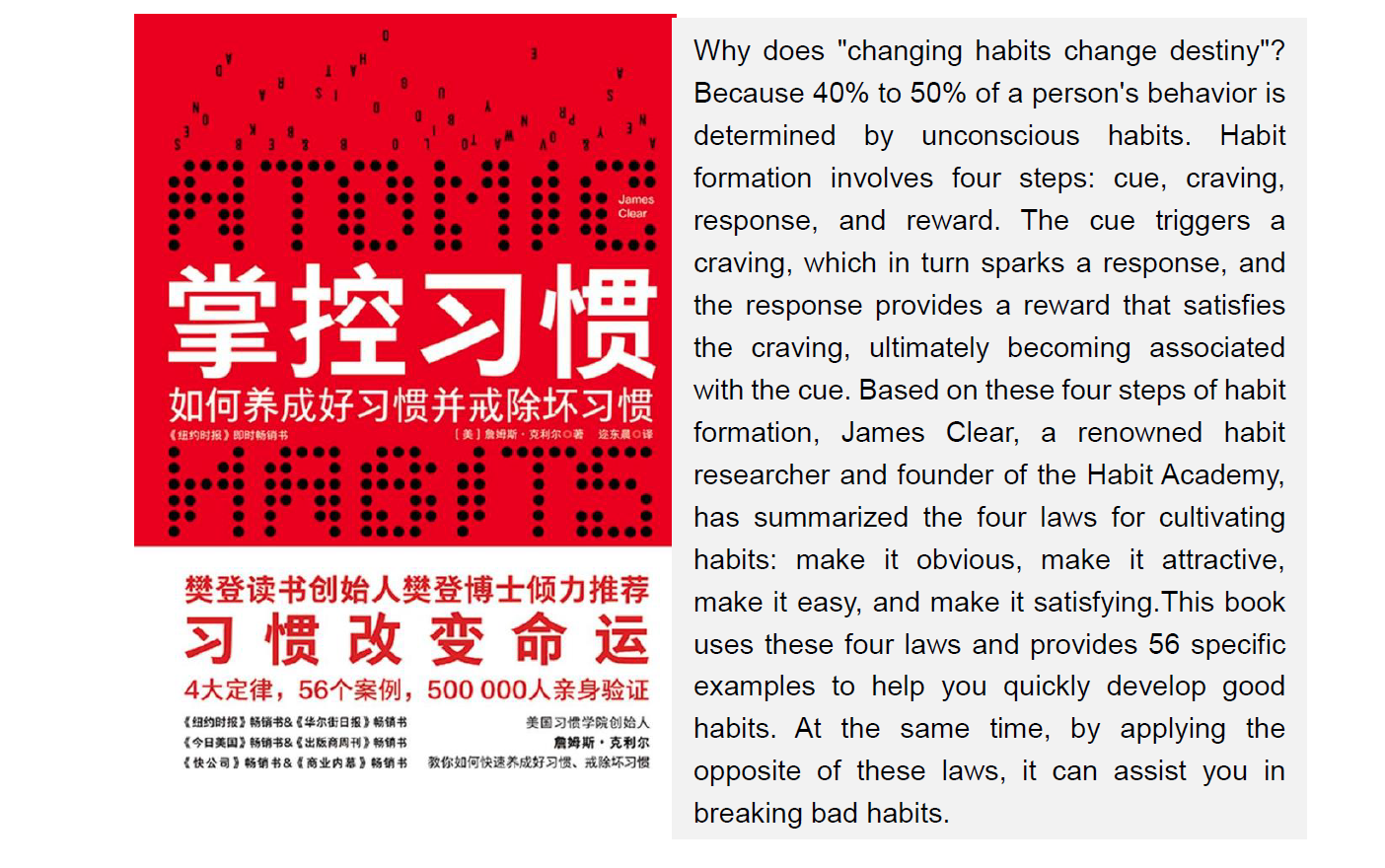
Our lives and work are products of time, and habits are behaviors that become automatic after enough repetition. The book provides a four-step model for cultivating habits: cue, craving, response, and reward. It also introduces four laws of behavior change derived from these steps: make it obvious, make it attractive, make it easy, and make it satisfying.Among them, the third law, "make it easy," has been particularly useful to me. When developing a new habit, the time invested should not exceed two minutes. One should not expect to cultivate a perfect habit right from the start. Instead, it is important to stay grounded and consistently perform simple actions. For example, in my case, to achieve continuous improvement in professional skills, it is essential to maintain uninterrupted practice and learning. Sometimes, due to busy work schedules, there may not be extended periods of time for in-depth thinking and research. In such cases, I have developed a habit of reflecting on and learning from my day's work before going to bed. This habit can start with something as simple as reading two pages of a relevant document each night. By persisting in this practice, seemingly small and inconspicuous changes will compound over time, leading to significant results.
The quality of our lives often depends on the quality of our habits. The habits we cultivate determine the results we enjoy. By developing better habits, anything is possible.
Based on my past experiences, I have come to understand the importance of habits.
I often push myself to cultivate habits, but I frequently struggle to achieve effective results. Therefore, I purposefully read this chapter to see if it could help me. And the answer is definitely yes.
To make habits irresistible, the most effective approach is to link them to our preferences. This means associating the desired habit with something we genuinely desire. Essentially, it leverages the brain's dopamine release and the 100% activation of the nucleus accumbens when engaging in desired activities, making it easier to cultivate habits.
In our work and personal lives, there are inevitably tasks we are willing to do and others that are important but less desirable. By consciously linking the things we are willing to do with those we are less willing to do, many problems can be solved. For example, in the book's example, if we want to develop the habit of exercising and break the habit of spending excessive time on our phones, we can perform ten jumping jacks every time we pick up our phones.
Every Lahigh employee has their own work tasks: some can complete them within working hours, some can accomplish them by working overtime, and some struggle to complete tasks even with overtime. The issue may lie in work habits. When faced with multiple tasks, efficient individuals will consider the order in which tasks should be tackled, while less efficient individuals will prioritize tasks based on who is urging them or simply start with whichever task comes to mind first.
Efficient individuals quickly adjust their focus to the second task after completing the first one, while less efficient individuals tend to relax and wait for someone to push them before starting the next task. Efficient individuals make every effort to solve problems and drive progress, while less efficient individuals try to avoid problems and procrastinate, causing delays. Efficient individuals only need to assign tasks and monitor milestones, while less efficient individuals not only need to assign tasks but also help prioritize them, continuously inquire about progress, and make adjustments.
As a result, efficient individuals accomplish a significant amount of work, while less efficient individuals struggle with overtime but produce less output. In 2021, it is important to help some individuals develop the ability to think independently, analyze problems independently, prioritize tasks based on their importance and urgency, and cultivate habits that emphasize "goals, time, and results."

In the project management department, communication is integral to the entire work process, and effective communication is beneficial for the smooth progress of work.
Habit 5: Seek First to Understand, Then to Be Understood, had a profound impact on me. "Understanding others" and "expressing oneself" are indispensable elements of interpersonal communication. First, it is crucial to understand the other person and then strive to make oneself understood. This is the key to effective interpersonal communication and requires changing the tendency to hastily offer advice or solve problems. In addition, it is important to cultivate the habit of empathetic perspective-taking. To gain understanding from others, one must first understand their perspective. Everyone desires to be understood and is eager to express themselves, yet often neglects the act of listening. Many times, people are willing to listen to others merely to interrupt them and express their own thoughts. Learning to express oneself and actively listen is a great way to understand others and be understood by them. Effective listening not only allows for more accurate information retrieval but also contributes to emotional connection between both parties. We must learn to comprehend the true meaning behind others' expressions rather than blindly interrupting when we think they are wrong and immediately expressing ourselves. Additionally, we should avoid fixed thinking patterns and misinterpreting others' expressions during communication. Only by maintaining effective communication can we ensure high efficiency in our work.
Among the seven habits, the one that has had the greatest impact on me is "Think Win-Win." It is not merely a skill but a philosophy of interpersonal communication. A Win-Win mindset allows us to view work and life as a stage for showcasing our talents rather than a competitive arena. In the long run, relationships based on Win-Win outcomes are more stable and enduring, rather than solely focusing on self-interest and gains or losses. As the ancient Chinese saying goes, "Great virtue must lead to a position, must lead to a reputation, must lead to longevity. Therefore, all living beings are produced by the heavens through their natural endowments. Those who nurture them will prosper, while those who harm them will perish." The underlying principle remains the same. I believe that the essence of Win-Win is actually finding the most suitable approach to problem-solving. Both parties involved in a cooperation have their own concerns and considerations. To achieve a Win-Win outcome, we need to take a step back and consider the problem from the other person's perspective. Just like when designing services for our clients, we should be able to propose solutions that meet their needs while also aligning with our own acceptable criteria and not violating any regulations. By doing so, we can offer more suitable and mutually acceptable solutions, leading to a Win-Win situation.


Reading is the cornerstone of growth, and reading is the beginning of a splendid life. East Coast Chemical Group provided its employees with the following good books in 2021:
1. "How to Make Your Image Worth Millions" [China] by Ingrid Zhang
2. "Why Elites are Time Managers" [Japan] by Shion Kabasawa
3. "The Life-Changing Magic of Tidying Up" [Japan] by Marie Kondo
4. "Flow: The Psychology of Optimal Experience" [USA] by Mihaly Csikszentmihalyi
5. "Man's Search for Meaning" [USA] by Viktor E. Frankl
6. "How to Sleep Well" [USA] by Lawrence J. Epstein & Steven Mardon
7. "The Checklist Revolution" [USA] by Atul Gawande
8. "Thinking, Fast and Slow" [USA] by Daniel Kahneman
9. "The Goal: A Process of Ongoing Improvement" [Israel] by Eliyahu M. Goldratt
Life is like a book that requires the heart and mind to explore; mountains and rivers are like books that require walking and reading with our feet; the sun and moon are like books that require the soul to comprehend. Books are the treasure troves of wisdom, and reading brings forth sparks of thought. In the beginning of the "14th Five-Year Plan," the company insisted on promoting a literary atmosphere and enhancing the quality of its employees. Excellent books, like ships, lead us to the vast ocean of life. Here, we have selected and shared some reading insights written by employees.

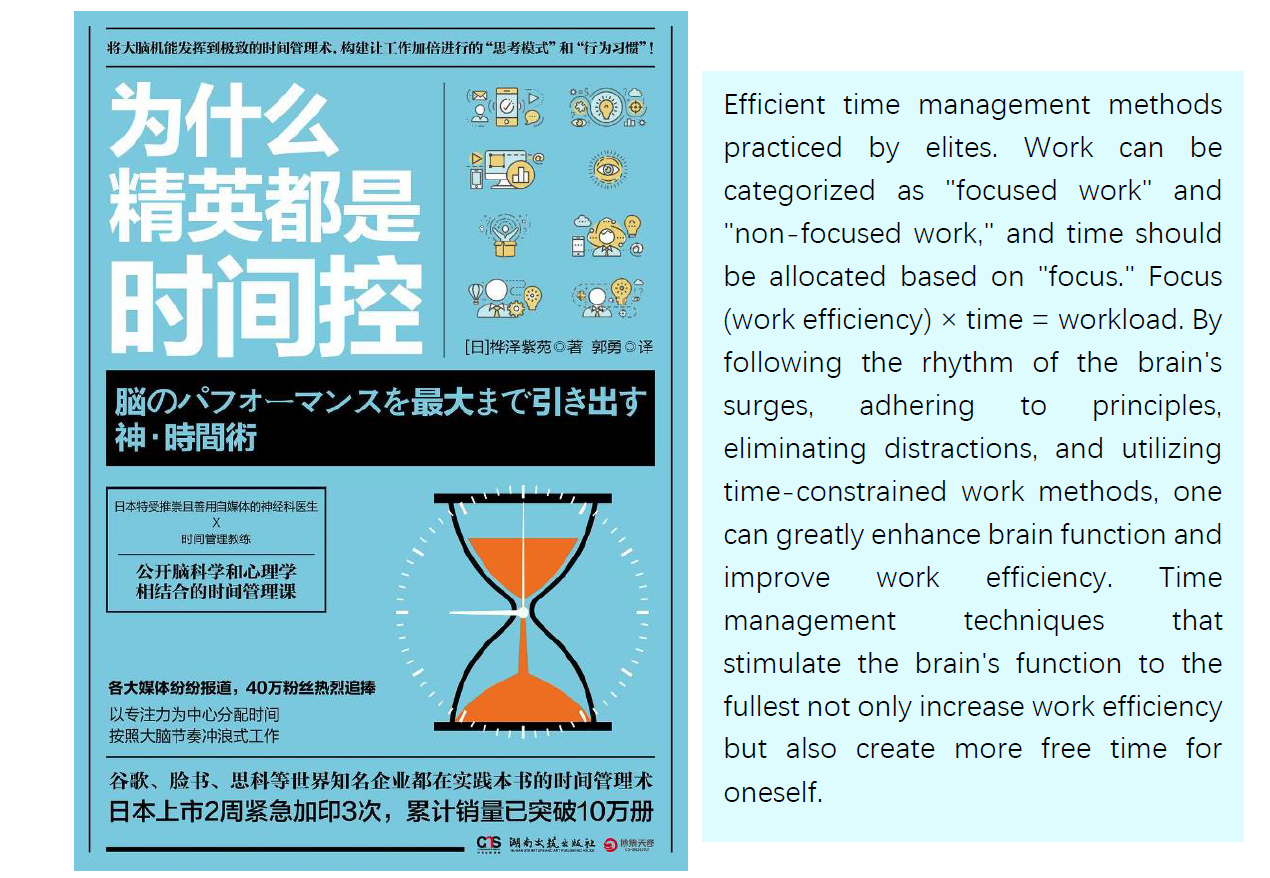
First Insight
In daily life and work, everyone faces various contradictions and needs to handle them efficiently. The book "The Most Efficient Work" provides valuable insights and considerations:
1. Timely record various events (project designs, coordination with various parties), categorize events regularly based on urgency and importance, and establish time-bound plans.
2. Act decisively; hesitation only wastes time.
3. Immediately handle tasks that can be completed in a few minutes to avoid future troubles.
4. Concentrate on important tasks, allocate uninterrupted time for important events, and avoid distractions.
5. Divide each day into high-efficiency and low-efficiency time periods based on the goals set in point 1, and ensure daily tasks are completed.
6. Make good use of spare time for necessary reflection.
7. Regularly review, summarize, and update short-term, medium-term, and long-term events, and then repeat the cycle.
Second Insight
The work method of "considering others": We naturally value our own time, but we should also empathize and respect the time of others. For example, as professionals responsible for providing specifications, we should prioritize tasks like "providing design requirements" that require other departments to wait. Similarly, as organizers of meetings, we should prepare in advance. In a meeting with 10 people, every wasted minute is equivalent to wasting 10 minutes. By adopting the work method of "considering others," we can improve the overall efficiency of the team.
The execution power of "seizing the present": We often set deadlines for project completion, but when it comes to the start of a project, there may be delays. I believe that seizing the present and starting work in a timely manner is crucial. If we view work as a line, with the project start time as the starting point and the project completion time as the endpoint, delaying the starting point can potentially affect the endpoint. Therefore, avoiding procrastination and starting now are essential. Many tasks become less challenging once we take the first step.
Ability to handle multiple tasks simultaneously: When trying to tackle two tasks that require careful thought simultaneously, our thinking tends to become confused, leading to low efficiency and a lack of worthwhile results. Instead, we should adopt a "parallel" work approach. While engaging in simple and repetitive tasks, we can use our idle brain time to contemplate more complex issues, maximizing the utilization of our cognitive capacity.
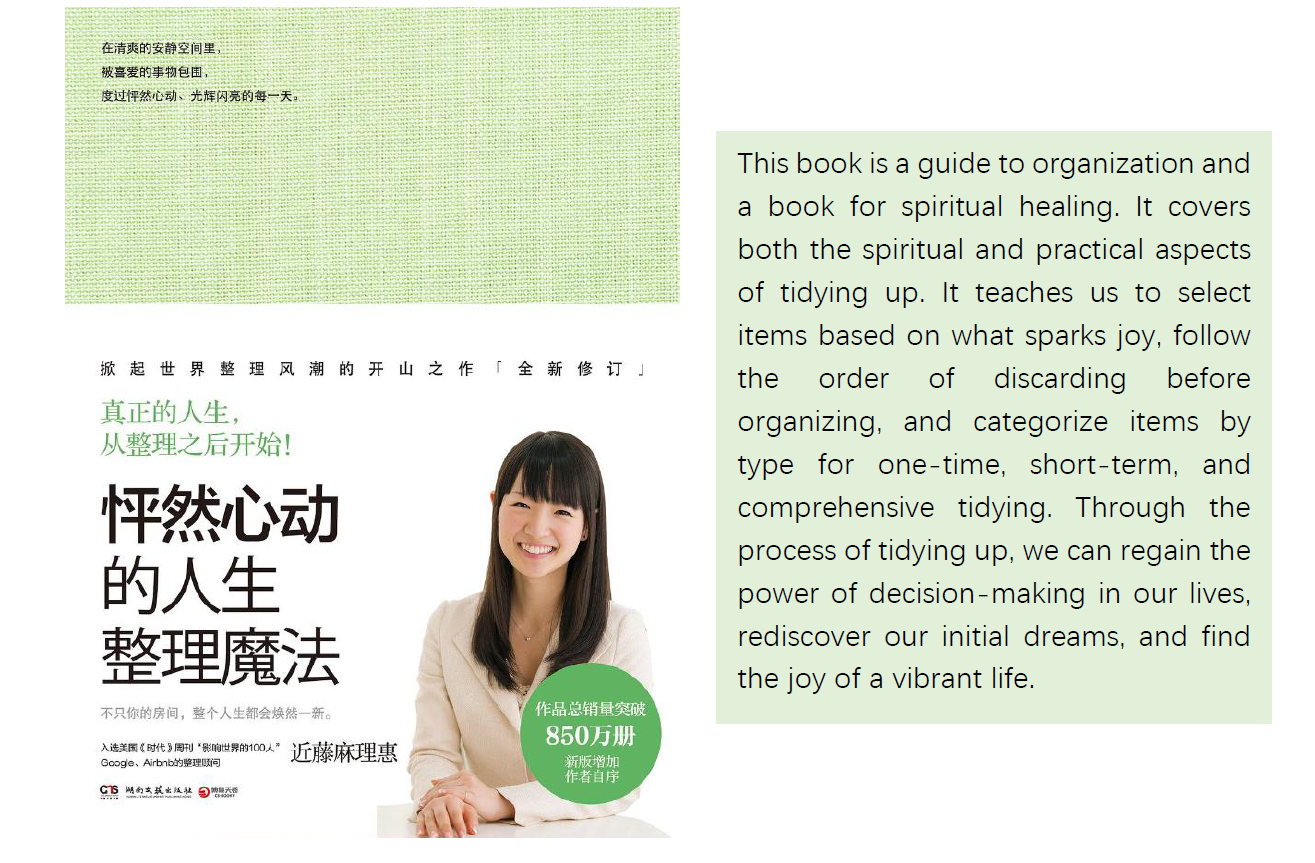
Third Insight
Success is composed of 99% perspiration and 1% talent. While we may not have that 1% of talent, if we invest 99% effort, we will undoubtedly outperform those who rely solely on their talent. When both parties invest 99%, time becomes the constant variable, and efficiency becomes the determining factor.There are many ways to improve efficiency, and organizing and summarizing are undoubtedly the simplest and most effective methods. Organizing our desks, organizing our computers, and creating order is not just for aesthetics but also for creating a systematic approach to the future, making it more efficient. The same principle applies to construction work.The preparation at the beginning of each day is the arrangement of the day's plan, and the organization at the end of each shift is to summarize and facilitate for tomorrow. Both are important. It's a repetitive cycle, orderly and systematic. Time carries both opportunities and measures achievements, but it also brings endings and rejects any regrets. Every minute and every second counts, neither more nor less.
Fourth Insight
Originally there was nothing, so why stir up dust? Organization is an eternal topic in life. Organizing clothes, organizing rooms, organizing interpersonal relationships, organizing life... As an ancient saying goes: A tree that can be embraced grows from a tiny sprout; a nine-story tower rises from a heap of earth; a journey of a thousand miles begins with a single step. The central idea conveyed in this book coincides with this: start by organizing everything around oneself, and it can change one's attitude towards life from the smallest details, thereby changing one's life.
Work is also an unavoidable and important part of life. Do not dwell on the past, do not waste mental energy on things that have already happened, but rather summarize the gains and losses and continue moving forward. Developing a habit of organization allows the present to be free of distractions and firmly focuses on the core issues. Grasp the key points and concentrate all mental energy on the most important matters. When all affairs are in order, it also broadens one's perspective and keeps the future from being chaotic. Proceed solidly and steadily, taking each step with confidence and firmness.

Fifth Insight
I want to make a contribution to society, to the world. However, as an ordinary person with average abilities like me, how can I make an extraordinary contribution? After careful consideration, I came up with this equation: Life • Work Results = Mindset X Passion X Ability. Since then, I have used this equation as the foundation of my thinking, both in my work and in my life.
The key to this equation lies in multiplication. For example, let's say someone has a sharp mind and scores 90 points for ability, but this person relies on their talent and lacks effort, with passion only worth 30 points. The product of the two would be 2700. On the other hand, another person may have mediocre abilities and only score 60 points, but they have self-awareness and compensate for their shortcomings with diligence. With a passionate dedication worth 90 points, the product becomes 5400, twice as much as the talented but unmotivated person. On top of that, we multiply by the "mindset" factor.
The reason why the "mindset" is crucial is that it has a directionality. In other words, the "mindset" can be positive or negative. Depending on the mindset, some people utilize their passion and abilities in a positive direction, while others veer towards negative outcomes. Since the "mindset" can be negative, the higher the scores for passion and ability, and if the "mindset" is a negative value, the product of the three (life • work results) would be a large negative number.
Since the equation for life is expressed as multiplication, the "mindset" must be directed towards positivity. Otherwise, even if you possess exceptional talent and overflowing passion, the result will not only be "having an empty bowl despite holding a golden one," but it may also harm society.

Whenever we question the meaning of life, the author expresses it as follows: "It is not important what we expect from life; what is important is what life expects from us. We should no longer ask about the meaning of life but instead think about ourselves as those who are constantly being questioned by life." This passage is particularly thought-provoking, and the more I read it, the more profound it becomes. Combined with daily life and work, it is especially enlightening.
The meaning of each person's life is different, and it varies at different times. It's like a movie; you can't fully understand the overall meaning until the end. No matter how difficult the situation, never forget to learn and grow. Because only then can you overcome adversity and see hope for the future. Escaping and laziness do not help solve problems. The meaning of life is to constantly improve oneself.
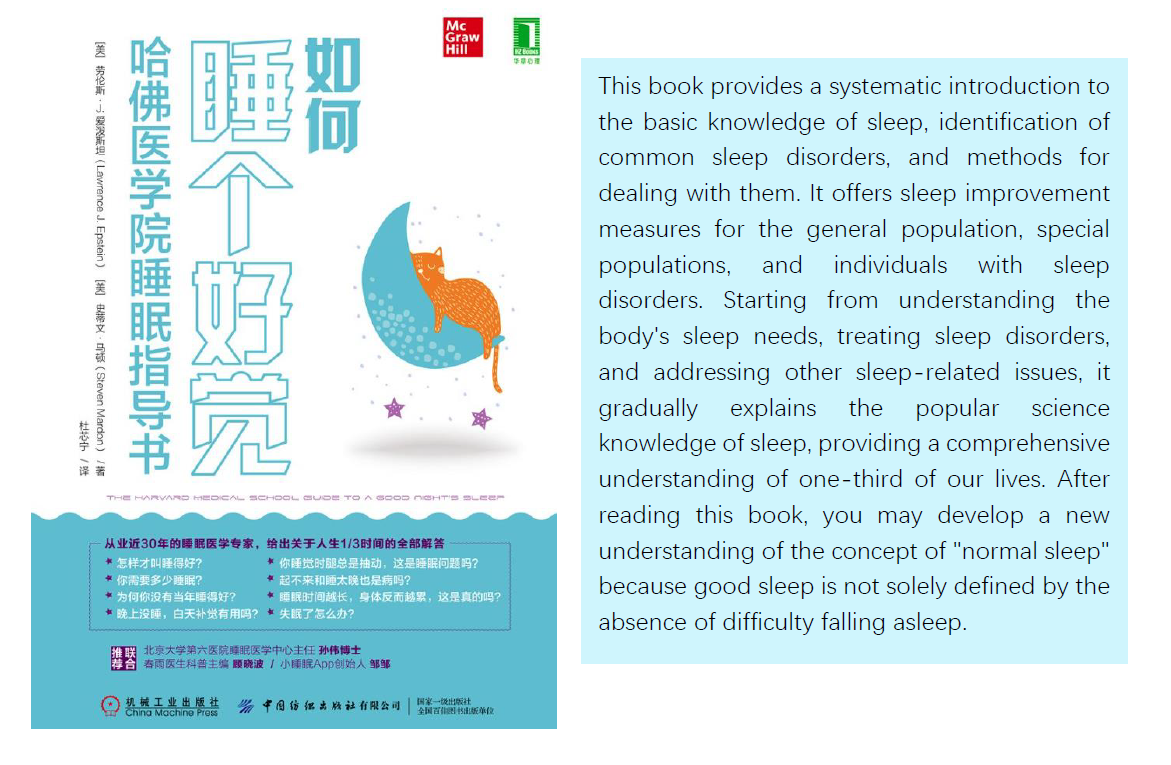
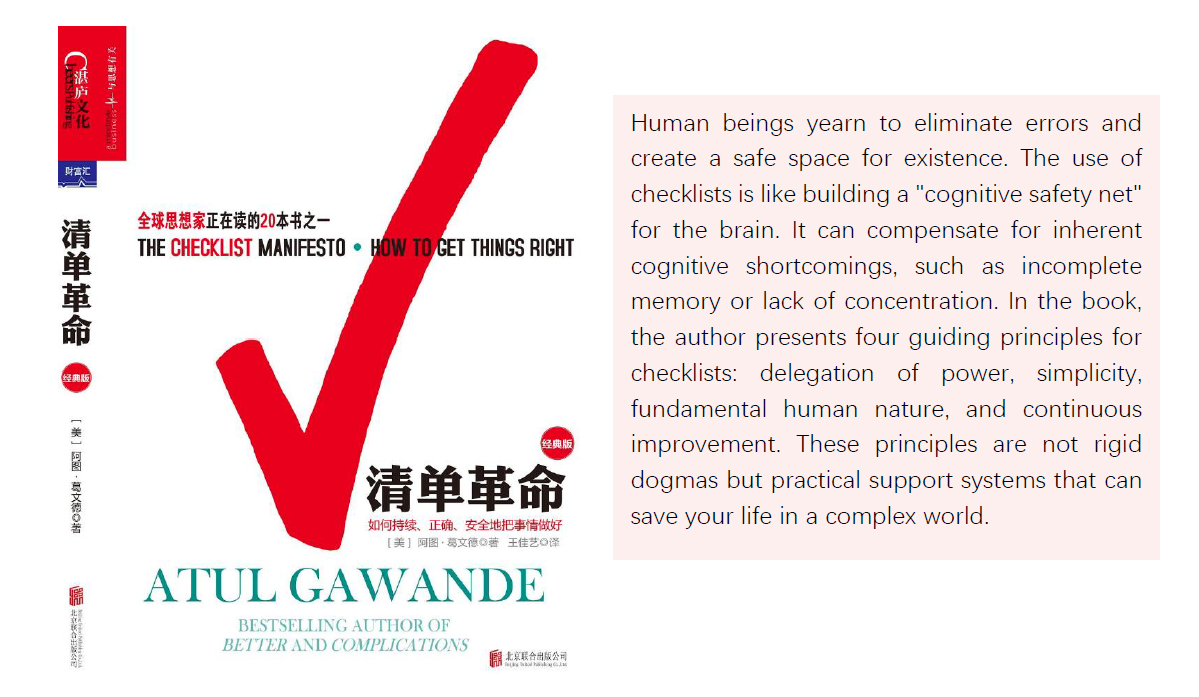
Seventh Insight
I believe that almost everyone has their own checklist to help plan their tasks and make their work more organized and systematic. Avoiding problems by better utilizing checklists is the main focus of this book.
The book presents several key points. First, teamwork can help us reduce errors. Second, focusing on "key points" is more important than having an exhaustive list. Third, checklists are created to solve problems. Therefore, the development of checklists must adhere to the principles of simplicity, measurability, and efficiency. By employing an effective checklist approach, we can improve our work efficiency and reduce mistakes. This book is highly suitable for individuals who feel overwhelmed by numerous tasks in their work and seek to use this tool to enhance their productivity and streamline their work processes.
Eighth Insight
The Checklist Revolution is a paradigm shift that uses checklists as a medium to improve the efficiency and stability of the entire team through the principles of delegation of power, simplicity, fundamental human nature, and continuous improvement, focusing on key points and details. In the context of company management, this can be exemplified by the application of OKRs (Objectives and Key Results):First step in OKR formulation: Team members collectively discuss and formulate team OKRs through goal crowdfunding, clearly defining the team's future efforts and improvement directions. Second step in OKR formulation: Using the team OKRs as a reference, individuals create their own OKRs, specifying their personal future efforts and improvement directions. First step in OKR implementation: When each individual completes their personal OKRs, the team OKRs are naturally achieved. Second step in OKR implementation: With each OKR update, completed goals are removed, and new goals for improvement are added. Each OKR formulation and assessment is a process of self-examination, self-revolution, and self-improvement for the team.

Author Daniel Kahneman uses engaging language and rich, detailed experimental cases to explain how two different thinking systems in our brain work: fast thinking, which allows us to quickly make judgments in mundane matters, saving time and energy, and slow thinking, which enables us to delve deeper, make rational decisions, and avoid making erroneous choices due to impulsivity. The book also specifically analyzes various pitfalls that can influence our thinking. Understanding these two thinking modes is highly beneficial for our daily life and work. Lastly, the book shares how to avoid the influence of various biases on rational thinking, primarily through the following points: slowing down the thinking process, utilizing the framing effect, seeking external opinions, and predefining unfavorable outcomes in advance.
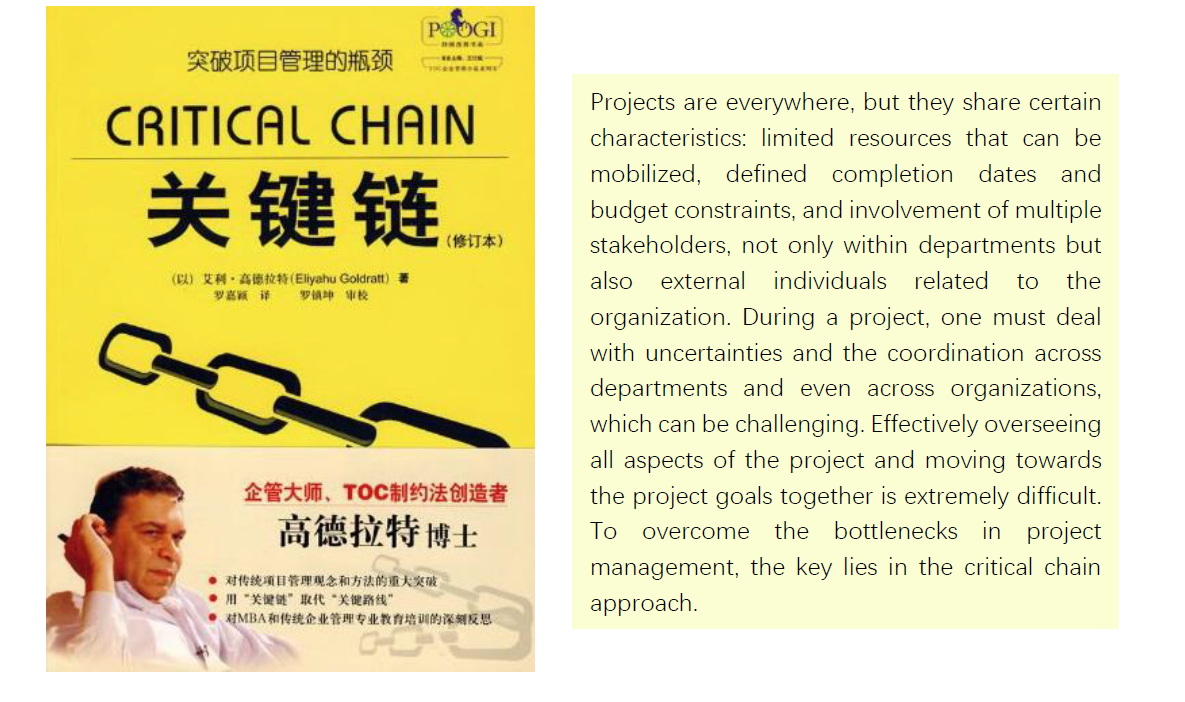
Tenth Insight
Parkinson's Law states that work expands to fill the time allotted for its completion. In other words, if a task allows for procrastination or delays, it tends to be postponed until the very last possible day, rarely completed ahead of time. In most cases, projects and tasks are delayed, or they are barely finished on time.
Consistent procrastination only breeds bad habits. It is essential to effectively manage one's time and utilize resources in various aspects to improve oneself.
Eleventh Insight
The book "Critical Chain" primarily focuses on project management techniques but also provides insights for designers.
Firstly, when starting a design project, analyze the technical issues and seek solutions for them. Avoid procrastination and aim to complete the work ahead of schedule whenever possible. Otherwise, there is a risk that other projects might require attention within the designated timeframe, leading to delayed or rushed completion of tasks.
Secondly, strive to improve work efficiency. If the current design tools are not optimal, find ways to enhance design skills and acquire more proficiency in tool usage. By doing so, the limitations of the tools can be overcome, ensuring the completion of tasks.
Remain composed amidst praise or humiliation, leisurely exploring the mysteries within books. Indifferent to gains or losses, wander through life following the path of books. This concludes the book reflections for 2021, see you in 2022!


To advocate for and cultivate a strong atmosphere of "reading books, reading good books, and reading more books," DKEC Group provided the following good books for its employees in 2022:
1. "The Willpower Instinct" by Kelly McGonigal
2. "Irresistible" by Adam Alter
3. "The Happiness Equation" by Neil Pasricha
4. "Peak: Secrets from the New Science of Expertise" by Anders Ericsson and Robert Pool
5. "You Are What You Eat" by Xia Meng
6. "The Power of Now" by Eckhart Tolle
Reading, for individuals, can help maintain mental vitality, stimulate intellectual growth and wisdom, and cultivate noble character. For companies, it can continuously enhance their soft power, cultural appeal, and enrich their cultural heritage. For society, it can elevate the moral literacy of citizens and the level of social civilization, promoting harmonious social development. Here, we have selected some book reviews written by employees to share with everyone.
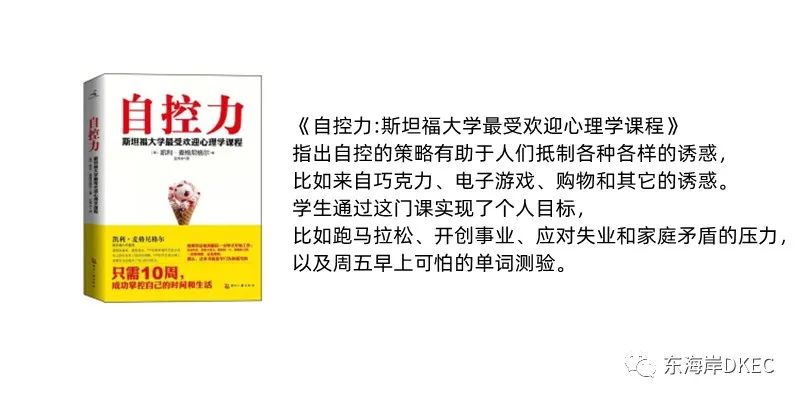
The first one
Self-control is a manifestation of strong willpower. In the complex social life, controlling one's own attention, emotions, and desires allows oneself to experience the joy of victory more in work and life. In reality, people often experience unsatisfactory results in work and life due to poor self-control, procrastination, and emotional outbursts.
We are more inclined to accept simple tasks and have a natural aversion to difficult tasks. When faced with both easy and difficult problems, we need to solve the simple problems first, and then focus on analyzing and solving the difficult problems. Instead of using the need to solve simple problems as an excuse or barrier, we should not ignore or indefinitely postpone the difficult problems.
When dealing with sharp issues in communication with others, we are prone to emotional fluctuations, which can manifest as irritability and even lead to arguments and conflicts. Emotional fluctuations do not contribute to problem-solving; they only bring greater difficulties to problem-solving. When communicating with others, control your emotions and focus on the problem. Look for key points, weaknesses, and breakthroughs.
The second one
Reading the book "The Power of Self-Control," my biggest takeaway is a deeper understanding of "how to harness willpower." Combining it with my own design work, I have the following insights:
Firstly, when self-control is needed, the most effective approach is to slow down rather than accelerate oneself (such as with stress reactions). "Think twice before acting" means slowing down and helping oneself suppress impulses when internal conflicts arise.
Secondly, it is important to know how to maintain focus and self-discipline, cultivating the exercise of willpower as a habit. People with strong self-control tend to work harder because they have transformed willpower into a spontaneous awareness. The process of turning willpower into a habit involves identifying various temptations and pressure points that make one feel inclined to give up, preparing corresponding habitual solutions, and then repeatedly practicing them until willpower becomes a spontaneous awareness.
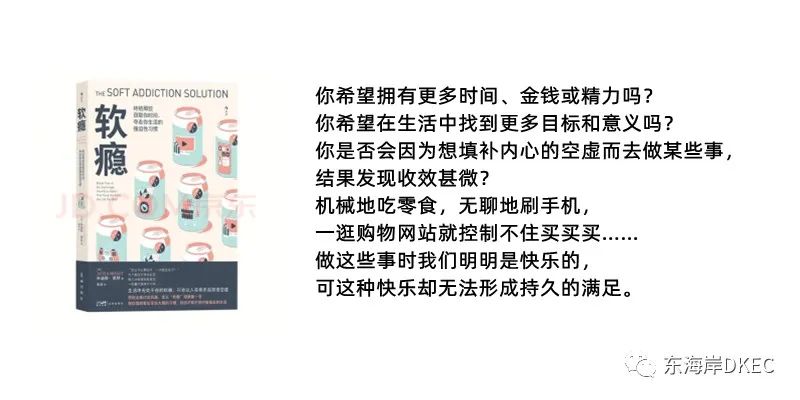
The third one
The so-called "soft addiction" refers to activities in our daily lives such as binge-watching, overeating, shopping, and so on. When we excessively repeat these activities, they turn into soft addictions. These activities may seem enjoyable and satisfying, but they consume a significant amount of our time and energy, severely damaging our lives.
The author categorizes soft addictions into four types: the first type is behavioral, the second type is avoidance behavior, the third type is related to emotions/lifestyle, and the fourth type is food/consumer goods. To break free from soft addictions, the best method is through addition and subtraction. Addition means adding meaningful activities to our lives, such as waking up early, exercising, reading, and staying connected with friends. This helps us develop good habits. Subtraction means reducing the time, money, energy, and resources we spend on soft addictions, such as watching one movie per week or buying one clothing item per month.
We don't have to strive for perfection in implementing addition and subtraction. We just need to take this opportunity to adjust the rhythm of our lives and enrich our life experiences.
The fourth one
Soft addictions, these compulsive habits, are ubiquitous in our work and life.
"I'll just follow the reference from previous projects," and as a result, we no longer actively think about innovation. "The previous projects were done this way, so it must be right," and thus we no longer reflect on our own shortcomings. When we encounter something that doesn't have a reference point, when we reevaluate what we need to do, when we no longer rely on experience and start from scratch, we will discover that this thing is different from previous referenceable matters. It will have new thoughts and perspectives compared to previous projects.
Break free from inertia thinking, break free from lazy thinking, and embrace the power of making core decisions.

The fifth one
"The Happiness Advantage" is a book on positive psychology written by Shawn Achor, a life coach who is highly popular among Harvard University students. From this book, I have gained a lot of knowledge and developed a different perspective and deeper understanding of "happiness." The most memorable quote for me is, "Happiness is a process that requires continuous pursuit. A happy life attitude involves not only striving for personal goals but also savoring every moment of the present. Sometimes, in the pursuit of goals, people may stray and unintentionally adopt a life of busyness or hedonism. We should not only focus on the outcomes but also value the process."
After reading this book, I started to seriously contemplate what happiness truly means. Whenever I encounter unhappiness and challenges in my studies and life, I strive to apply the methods of happiness mentioned in the book and transform myself into a "perceptive happiness-oriented" person. Happiness is ubiquitous, and if you are still puzzled by happiness or aspire to become someone who perceives happiness, I believe "The Happiness Advantage" is a great choice.

The sixth one
"Deliberate Practice" is a book co-authored by American psychology professor Anders Ericsson and scientist Robert Pool. The book clearly explains how ordinary people can reach the level of a professional master through deliberate practice. It has also provided me with some insights into improvement in my work.
1. All success requires scientific practice. It emphasizes that mere repetitive practice is not enough to achieve success. This can be observed in our design or marketing work as well. Although we may spend long hours working, sticking to the same methods often hinders improvement. It is important to have targeted training for each project in order to have a chance to improve.
2. The importance of stepping out of the comfort zone. People tend to seek stability and often prefer convenient methods to achieve certain goals. However, this leads to mediocrity in work and a satisfaction with the existing situation, which is detrimental to personal development. Only by stepping out of the comfort zone and entering the challenge zone can we better discover our hidden potential and achieve greater accomplishments.
3. The practice of deliberate practice in work, creating a structured training plan, and integrating practice into daily work is an excellent approach. For example, turning different training exercises in the marketing department into daily routines can greatly enhance the capabilities of the team.
The biggest takeaway from this book is that anyone can achieve success in their field through effective practice.
The seventh one
The book "Deliberate Practice" is written by Dr. Anders Ericsson and Dr. Robert Pool. The book builds upon the concept of the "10,000-hour rule" proposed by Malcolm Gladwell in his book "Outliers," suggesting that genius is not born but developed through approximately 10,000 hours of dedicated practice. However, this statement is problematic. It's not about randomly practicing for 10,000 hours to become an elite; the key lies in how to conduct those 10,000 hours of practice and whether it is effective. So, what is deliberate practice? It refers to focused and goal-oriented practice, while also paying attention to the shortcomings in each practice session and promptly seeking reasons for improvement. Otherwise, no matter how much you practice, you won't achieve the desired results. Just like when we enter the workforce, there are many tasks we don't know how to do. When receiving guidance from others, it's not about blindly imitating but engaging in deep thinking, which enables us to truly understand and gain insights.

The eighth one
I have summarized the common foods for the seven major nutrients mentioned in the book, aiming to provide everyone with suggestions for balanced and well-combined meals:
√ Carbohydrates: Essentially equivalent to the staple food, such as rice and grains.
√ Protein: Animal protein is superior to plant protein, including meat, eggs, and dairy. It is important to note that soy milk cannot replace milk.
√ Fats: Plant oils, animal fats, nuts, subcutaneous fat of animals, fish oil, etc.
√ Vitamins: There are various types of vitamins distributed in different meats, fruits, and vegetables. Avoid being picky and try to consume them from multiple sources.
√ Minerals: Common trace elements include calcium, phosphorus, magnesium, potassium, etc. Animal-based foods are better sources of minerals than plant-based foods.
√ Dietary fiber: Beneficial for digestion, weight management, and reducing post-meal blood sugar levels. Mainly found in vegetables and fruits.
√ Water: For patients with kidney disease, it is necessary to assess whether there is edema and consider the condition when determining the water intake. Follow medical advice.
Having a variety of food does not necessarily mean having a nutrient-rich diet. To avoid consuming a lot of different foods without meeting the body's nutritional needs, it is recommended that you try to incorporate the following foods into your daily meals: eggs (kidney disease patients should focus on consuming egg whites), milk, green vegetables, lean meat, fish, nuts, fruits, and whole grains.
By conscientiously practicing "moderation in eating and drinking, regularity in daily routines, and avoiding excessive physical exertion," you can maintain good physical and mental health, live a full life, and reach a hundred years before departing.
The ninth one
Reading "You Are What You Eat" and my personal experience, I have summarized the dietary precautions during a fever caused by COVID-19. With the sudden relaxation of domestic epidemic control measures, everyone will have to directly face COVID-19 in the coming period. By reading this book and applying it in my own life, I have gathered the following dietary precautions to take during a fever caused by COVID-19.
1. The best medicine: Breakfast, lunch, and dinner
During the COVID-19 fever period, you may lose your appetite, especially on the first and second days, even experiencing nausea. However, it is important to have complete meals as they continuously provide the energy needed for the immune system to eliminate the virus. Therefore, try to eat a few bites during each meal, which is crucial.
2. Carbohydrate balance: Consider energy expenditure
During the COVID-19 fever, carbohydrates are the main source of energy. Therefore, it is necessary to replenish an adequate amount of carbohydrates. Ideally, control the intake based on physical exertion, ensuring that you don't feel hungry between meals. Recommended carbohydrate sources include rice, congee, steamed buns, etc. If blood sugar control is necessary, incorporate some whole grains.
3. Water balance: More than just 8 cups a day
Water is involved in the body's metabolism and substance exchange within the microcirculation. During the COVID-19 fever, water also helps regulate body temperature, transport nutrients and oxygen, eliminate waste and toxins, and lubricate and protect organs and tissues. It is recommended to consume 2 liters of drinking water per day.
4. Vitamin balance: Easy to be deficient, difficult to overdose
Vitamins are essential elements for many important physiological processes in the body. In simple terms, consume liver, eggs, carrots, pumpkin, spinach, and broccoli for vitamin A; milk, eggs, legumes, liver, and nuts for vitamin B; consume three types of fruits daily for vitamin C; and get sunlight exposure for vitamin D.
5. Mineral balance: A little goes a long way.
In regular dietary habits, it is often recommended to consume less salt. However, during the COVID-19 fever period, rapid fluid loss accelerates the loss of minerals and electrolytes. Therefore, it is advisable to have slightly saltier meals during the three daily meals. Functional beverages and electrolyte water can also be consumed.
I hope everyone can avoid infection as much as possible. If infected, don't panic. Take the time to rest and recover before returning to work.

The tenth one
In life, most of us have encountered setbacks. When faced with setbacks, we often feel sad for our misfortune. At that moment, you may think, "If only I had enough money, if only I had perfect love, then I would be happy without experiencing that unforgettable failure and pain."
So you live in your future and past, feeling anxious, sad, restless, suppressed, and miserable, constantly worried and unable to find peace, but never truly facing and experiencing the present moment, content with the now. However, you overlook the fact that the countless moments of the future are made up of countless present moments, and those present moments will become countless past moments. If you can't grasp the present moment, you will lose today, tomorrow, and yesterday, and ultimately happiness will elude you, leaving you with nothing.
It wasn't until the day before yesterday when I finished reading Eckhart Tolle's "The Power of Now" that I started to think deeply. How can we live in the present moment and be happy and content even without achieving or having what we desire? The book, in a philosophical and logical manner, shows us how our thoughts and unconsciousness lead us away from the present moment, as we constantly live in the inertia of thinking and the pursuit of self-worth.
In reality, we can only live in the present, in this very moment. Everything must happen in the present, while the past and future are merely meaningless concepts of time. Only by surrendering to the present can we find true power and access peace and tranquility. There, we can find genuine joy and embrace our true selves.At the same time, I also understand that ordinary people have their own kind of happiness. If one can be content and peacefully face the ups and downs of life, calmly deal with minor troubles, and enjoy their little joys; if the wealthy can acquire wealth in a righteous and contented manner, benefit society, and achieve fame and fortune, they too can taste the flavor of happiness.
The eleventh one
"The Power of Now" enlightens us to face life with a new way of living. You may see time as a means of redemption, but in fact, time is a major obstacle to redemption. The past is gone and will never come back, yet how many of us still live in the past and refuse to let go? The future has not yet arrived, and you cannot possibly grasp it. All you have is this present moment, isn't it? No one can predict what will happen in the next second, so why waste precious time in the anxiety of the unknown? Regardless of which stage of life you are in, living in the present is the best state of being!
Sometimes, I feel confused about my current work. The lack of theoretical knowledge and unfamiliarity with practical operations often lead me to anxiety. However, just as this book suggests, when facing life and work, we often cannot escape the constraints of conditions or forms, but we can at least choose our attitude towards them. In work, change your cognition and no longer be a prisoner of your own thoughts. Let go of the entanglement with the past, let go of the confusion about the future, and focus on the present. Learn from shortcomings, put on your armor, and move forward with determination.
Live in the present, cherish the present moment, continuously improve yourself, accumulate energy through daily progress, and face the future with composure. When the heart is at ease, life blossoms with flowers.
Every time we summarize and archive, it marks a new and exciting beginning! This is where I'll end my book reflections for 2022. See you in 2023!


Reading is a portable refuge- W.Somerset Maugham
To promote and foster a strong atmosphere of "reading, reading good books, and reading many books," DKEC provided the following books for its employees in 2023, encouraging them to "learn and cultivate their ways".
∞∞∞∞∞∞∞∞∞∞∞∞∞∞∞∞∞∞∞∞∞∞∞∞∞∞∞∞∞∞∞∞∞∞∞∞∞∞∞∞∞∞∞∞∞∞∞∞∞∞∞∞∞∞∞∞∞∞∞∞∞∞∞∞∞∞
1. "Human Hacking" by Christopher Hadnagy and Seth Schulman (USA)
2. "Tribe of Mentors" by Tim Ferriss (USA)
3. " The Power of Full Engagement" by Tony Schwartz and Jim Loehr (USA)
4. "Stress-Free Living" by Jin Bo (China)
5. "Believe" by Cai Lei (China)
6. "Are Your Lights On?" by Gerald M. Weinberg and Donald C. Gause (USA)
∞∞∞∞∞∞∞∞∞∞∞∞∞∞∞∞∞∞∞∞∞∞∞∞∞∞∞∞∞∞∞∞∞∞∞∞∞∞∞∞∞∞∞∞∞∞∞∞∞∞∞∞∞∞∞∞∞∞∞∞∞∞∞∞∞∞
Reading is spiritual nourishment, just like eating when hungry, drinking when thirsty, and sleeping when tired. When facing difficulties in life and work, turn to books. Books may not always provide answers to your questions, but they can free you from dwelling on certain issues. They enable you to speak with tact, play with moderation, and conduct yourself with integrity. Reading makes you a person with warmth, taste, and the ability to think, all to ensure you have an unwavering inner strength amidst life's ups and downs. It prepares you to navigate through the long and dark phases of the future. Here, we have excerpted some of the book insights written by employees to share with everyone.
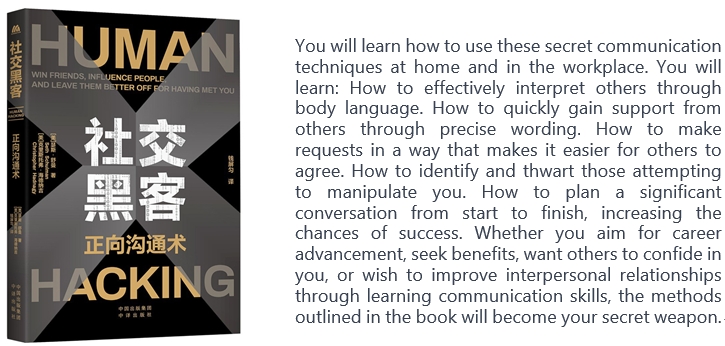
The first one
In today's rapidly advancing technological era, people are often inclined to cocoon themselves within their online social bubbles, neglecting the opportunities for face-to-face interactions with those around them. This book teaches individuals how to engage in effective social interactions, achieve their desired outcomes in social situations, and leave others feeling enriched by their encounters.
To extract the information one desires through communication, understanding one's own communication style is crucial, playing to one's strengths and avoiding weaknesses to increase the likelihood of success. Creating a conducive atmosphere during initial encounters helps establish basic trust, making others more willing to accommodate requests. Utilizing influence in social situations not only makes it easier for others to share information but also boosts one's confidence and enhances interpersonal relationships. Compared to the power of words, body language and facial expressions are more persuasive in getting others to meet one's needs and offer a better understanding of the other person's psychological state. Social skills are not acquired overnight; they require continuous practice and adjustment of interpersonal strategies to minimize mistakes.
Whether engaging in conversations with clients or communicating with colleagues, it is essential to empathize with their emotions, consider their perspectives, approach interactions with sincerity, and strive to build harmonious relationships. By employing influential techniques, one can encourage others to willingly meet their requests. Empathy leads to mutual success.
The second one
With a gray cover exuding a sense of professionalism and simplicity, it complements the content of the book well. Adequate preparation is essential before engaging in conversations and communication, ensuring that the dialogue is concise, swift, and the expression is clear.The success of every business transaction hinges on effective communication. Preparing a predetermined "strategy" before initiating a conversation can help prevent the transmission of incorrect information and swiftly achieve the set objectives.
It is beneficial to cultivate the habit of devising a "strategy" before important events such as meetings, presentations, and negotiations. By anticipating potential issues, deducing possible scenarios, and formulating effective responses, one can ensure that the preparation is thorough and yields maximum results.

The third one
“Tribe of Mentors" is a masterpiece by Tim Ferriss. Through in-depth interviews with successful individuals from various fields, the author provides us with a profound understanding of the methods and strategies employed by many accomplished individuals. Through their stories and experiences, the author reveals that success is not accidental but requires effort, perseverance, and the right approach.
One of the most memorable aspects of the book is the mention of the "recipe for success." This formula includes elements such as self-awareness, goal setting, time management, healthy habits, and interpersonal relationships. These elements are interconnected and mutually influential, and only by comprehensively mastering them can one truly stride towards success.
Moreover, the book introduces numerous practical methods and techniques, such as how to enhance focus, cultivate creativity, and engage in effective communication. These methods and techniques not only help us become more efficient and successful in our work but also contribute to a better understanding of ourselves and personal development.
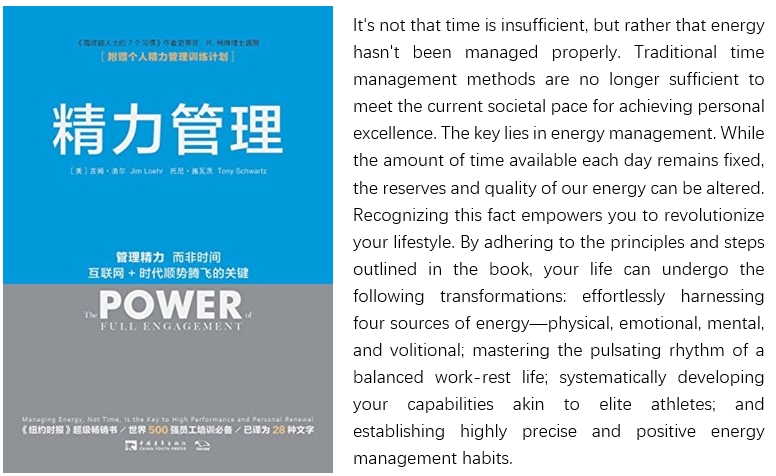
The fourth one
The author of this book focuses on theories about energy management and specific methods to enhance energy through energy management. However, it can be observed from the side that successful individuals, both domestically and internationally, are often in a "busy" state, and it can be said that "busyness" is a norm. In the midst of busyness, how to manage one's body well and thereby enhance energy, I have identified several key points in this book, summarized as follows.
1.Adequate sleep: Ensure 8 hours of sleep.
2.Plan your diet: For example, have breakfast on time, adopt a strategy of eating small meals frequently to avoid rapid blood sugar spikes that can quickly deplete energy. You can include grains, eggs, and a moderate amount of rice and noodles in your diet.
3. Improve physical fitness: Engage in physical activity 3-5 times a week, incorporating both aerobic and anaerobic exercises. For example, combine activities like jogging, cycling, weight lifting, and sit-up.
4. Follow the laws of nature and physiology: Focus on work for 90 minutes, then take a 15-minute break.
5. Make good use of “overcompensation”: Systematically push yourself to the limit, then allow for ample rest. After the body recovers, it gains more stress resistance.
The fifth one
Modern work and life are filled with uncertainty and challenges, causing many people to struggle and live a difficult life. After reading the book "Energy Management," we have found corresponding strategies and methods.
Energy is composed of four major factors: physical, emotional, mental, and willpower. Conventional thinking often recognizes the role of physical energy but tends to overlook the influence of the other three aspects. For some individuals, it is precisely these latter factors that have a greater impact. For example, in certain jobs like marketing and management, fatigue caused by emotional, mental, and willpower factors cannot be effectively improved through simple physical conditioning. Targeted training is needed. For instance, if experiencing low mood, engaging in activities one enjoys to alleviate emotions and provide a source of energy is essential. Particularly, cultivating willpower energy can greatly contribute to enhancing overall energy. It requires passion, a spirit of wholehearted dedication, and the cultivation of correct values and goals.
The sixth one
The book introduces us to the energy management training system, and the concept of aligning with one's passions left a lasting impression. A good concept requires a careful balance. On one hand, to spark inspiration, ambitious goals are needed, even ones that may seem beyond current capabilities; on the other hand, for practicality, a down-to-earth and meticulously planned approach tailored to individual circumstances is necessary. Inspired by this book to enhance my energy management, I commit to the following.
1. First and foremost, elevate my energy sources. Consistently engage in gymnastic exercises after returning home every evening and incorporate outdoor activities on weekends to boost physical energy. Strive for timely meals, regular breaks, and ensure ample sleep.
2. Avoid arrogance and impatience, control my emotions, maintain patience and an optimistic mindset in communication with colleagues. Engage in conversations with family and friends to expand emotional capacity and find joy in life.
3. Define realistic and optimistic goals in both personal and professional aspects of life. Actively work towards achieving them.
4. Live and work with passion, honesty, and integrity. Grounded in reality, meticulously plan to implement and achieve goals.
5. Perseveringly enhance physical, emotional, mental, and willpower energy. Improve energy management capabilities consistently for increased work efficiency and the successful completion of tasks.
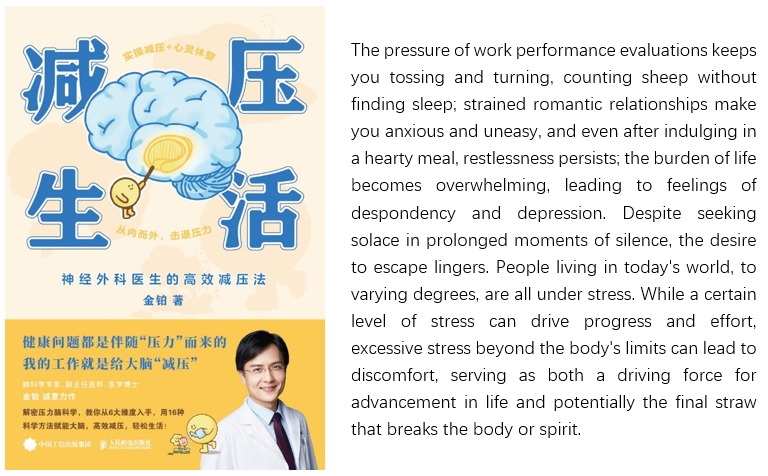
The seventh one
The pace of modern life is accelerating, and societal competition is becoming increasingly intense. Many people find themselves in a suboptimal state of health, often experiencing feelings of "mental fatigue," "weakness," and a lack of energy, all of which are often results of various pressures. In some cases, this may even lead to conditions such as depression. Stress is a natural response of the brain to external stimuli, and around us, there are generally two types of people: those with abundant energy and strong psychological resilience, and those who appear worried and disheartened, carrying a gloomy demeanor.
Regardless of whether it's in work or daily life, stress is constantly present. However, it's crucial not to let stress negatively impact our health. Here are a few ways to cope.
1. Exercise: Physical activity is an effective stress reliever. When you feel weary, engaging in exercise, breaking a sweat, can lead to better sleep and a refreshed feeling the next day.
2. Occasional Relaxation: Taking occasional breaks can help alleviate stress. When feeling overwhelmed, consider giving yourself a day off to indulge in good food, enjoyable activities, and simply savor the present moment to readjust your state of mind.
3. Quality Sleep: Much stress can stem from poor sleep quality. Periodically set aside all worries, relax, and ensure proper rest to recharge and revitalize.
4. Learn to Release: Find a secluded place, shout out loud, and let out your frustrations. You'll likely realize that there's nothing insurmountable.
Most importantly, transform stress into motivation. Everyone faces stress, but facing it positively, changing your mindset, conquering it, is the key. Don't let stress defeat you; instead, use it as a driving force for growth.
The eighth one
In the book "Stress-Free Living" by Jin Bo, a neurosurgeon approaches stress reduction from a scientific perspective and introduces 16 highly effective methods. Considering my own work and life, I've identified several approaches that suit me:
1. Progressive Practice to Combat Anxiety: Faced with tasks I'm not proficient in, I experience nervousness and anxiety. To counter these emotions, I engage in repetitive and progressive exercises, gradually confronting and relaxing my mind to alleviate or even eliminate anxiety and fear.
2. Balancing Focus with Moments of Relaxation: To maintain high efficiency in concentration, I allow myself occasional moments of mental relaxation. I cycle between a state of daydreaming and focused attention.
3. Minimizing External Distractions: Achieving a state of intense focus on a specific task, entering a state of absorption, involves blocking out external information, especially distracting stimuli. By maintaining a single channel of thought, I reduce mental load and efficiently complete tasks.
4. Cognitive Shifts and Proactive Abandonment: Actively discarding unproductive thoughts and taking initiative to reject them from my mind, rather than being forced to abandon them, helps in cognitive restructuring.
5. Adjusting Thought Patterns and Breaking Habits: Changing detrimental habits and avoiding the "broken window effect," where a small issue leads to a cascade of problems. Embracing a mindset of either zero occurrences or an infinite number of occurrences.

The ninth one
I believe, beyond despair, there is hope; I believe, after effort, there is possibility; I believe, above life, there is meaning.
Flipping through Cai Lei's 'Believe' for the first time, I didn't know what kind of world I was stepping into. As my thoughts delved deeper, I seemed to see a real him standing in front of me, with a determined gaze and far-reaching vision. This kind of belief is precious—after numerous struggles, reflections, and seeing the truth of life, he still chooses to love life and stay positive, which is truly moving.
In life and work, tranquility is not everlasting. When faced with something beyond our capacity, we often choose to escape, to avoid confronting it. However, such avoidance only makes us weaker. Instead of that, it's better to march forward boldly, believing in our own abilities and potentials, trusting in the beauty and positive energy of life. Face challenges head-on, believe in yourself, and forge ahead, blossoming all the way.
I believe, I can do it!
The tenth one
Having finished reading "Believe," I couldn't wait to type "Cai Lei" into the search engine. I was eager to find out whether this fighter who battled Amyotrophic Lateral Sclerosis (ALS)—a terminal illness with a 0% cure rate over nearly 200 years, with a survival period of 2 to 5 years— for almost 4 years, was still among the living. The results were comforting and deeply admirable. In December of the 23rd year, he was still delivering a video speech at a certain biomedicine forum.
In the current prevalence of embracing a passive lifestyle, Cai Lei's persistence, resilience, and determination have become a rare virtue. Without medical knowledge, he learned from scratch; lacking a data platform, he lobbied fellow patients to build one; with no existing drugs, he approached pharmaceutical companies for research; without money, he pitched, live-streamed, and earned funds on his own; even if the drug failed and the money ran out, he still had his body to donate, offering hope to the next generation.
"Give me two punches, and I'll sweep your leg; even if you're a thousand times stronger than me," this has been Cai Lei's consistent attitude towards challenges. With courage and determination beyond the reach of ordinary people, even as his health deteriorated, he did not withdraw from the battle against the disease. Even if ultimately knocked out by ALS, the world will forever remember everything he did.
A frequently mentioned term in the book is "hope." He said it's not because there's hope that he strives, but because of his efforts, he sees hope. Reflecting on myself, quick to give up, not only am I ashamed, but I ask myself, have I really worked hard for my life? Have I put in the relentless effort like Cai Lei? Have I persisted even when misunderstood and maligned, forging ahead despite knowing the odds are against me?
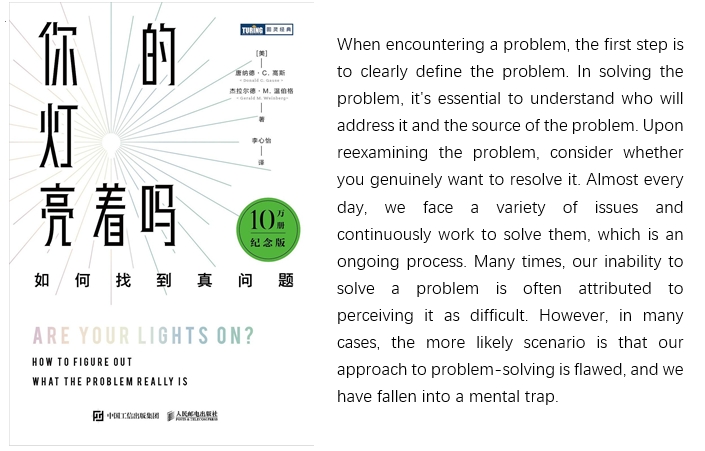
The eleventh one
In the book "Are Your Lights On?" a story is told about how to remind drivers to switch on their headlights when entering and exiting tunnels based on the surrounding environment. The ultimate solution presented is to create a slogan, "Is Your Light On?" The brilliance of this story lies in the fact that the subject of turning the lights on or off is the driver, not the traffic designer. In other words, the problem solver for such issues is not us but another group of people. This problem doesn't require us to solve it; we just need to capture the attention of those who need to solve it.
Conflict resolution skills follow a similar principle. Conflict arises when there is a gap between reality and our expectations. To bridge this gap, we need to control our emotions, reconstruct the sequence of events, see the other party as a fellow human, and then work towards resolving the conflict. When conflicts persist without resolution, it indicates that you've encountered a conflict that doesn't actually need solving. Through various techniques, we can avoid such situations. If the problem occurs for the first time, focus on the content—what happened. If the problem repeats, focus on the pattern—what causes it to happen repeatedly. If the problem occurs multiple times, then it's time to focus on the relationship—what made the other party behave this way. Once the target of the conflict is identified, reset the standards of expectations and use approaches that don't cause resentment to resolve the conflict.
The twelfth one
Learning a particular skill methodically and facing a task alone are basic capabilities in a profession. However, any "master" is distinguished by their ability to handle problems.
There are three stages in problem-solving: encountering a problem, resolving it, and reexamining it. Discovering a problem involves delving into the root cause beyond its surface appearance. Analyzing the root cause helps in clarifying your thoughts. Digging deeper by asking "why" several times at the root cause and proposing three different solutions from various perspectives render the superficial answer less important. What matters is that you've grasped the core and essence of the problem, which remains constant amid various changes.
Problem-solving is a high-level thinking process. Quickly identifying the core of a problem allows for swift resolution, making you a "master" in handling issues.
∞∞∞∞∞∞∞∞∞∞∞∞∞∞∞∞∞∞∞∞∞∞∞∞∞∞∞∞∞∞∞∞∞∞∞∞∞∞∞∞∞∞∞∞∞∞∞∞∞∞∞∞∞∞∞∞∞∞∞∞∞∞∞∞∞∞
Love reading!
Let's cherish the love for reading together, cultivate good reading habits, be friends with books, enjoy the pleasure of reading, let the fragrance of books accompany our lives, and let wisdom illuminate our future!


To advocate for and create a strong atmosphere of "reading books, reading good books, and reading more books," and to encourage employees to "learn to master their way," DKEC has provided the following excellent books for employees in 2024:
1.The Glucose Revolution by Jesse Anzospé (France)
2.Your Brain at work by David Rock (USA)
3.The Mountain is you by Brianna West (USA)
4.The World I See by Fei-Fei Li (USA)
5.Getting Things Done: The Art of Stress-Free Productivity by David Allen (USA)
6.Big Client Sales by Xu Hui, Qi Yangyu (China)
Reading, for individuals, can help maintain mental vitality, inspire wisdom, cultivate a noble character, and lead to success. For companies, it can continuously enhance the company's soft power, cultural charm, and enrich cultural heritage. For society, it improves civic moral standards and social civility, promoting harmonious social development. Reading helps us calmly and rationally accept everything life gives us, while also providing the courage, determination, and perseverance to face life. Here, we share some selected reading reflections written by employees.

1
Excessive glucose intake is a common issue in modern society. Drinks, milk tea, cakes, desserts, and various delicate snacks often lead to high blood glucose levels. Managing glucose is something that everyone is connected to. Rather than seeking medical treatment after falling ill, it is better to develop good habits in advance. The foundation of these habits lies in the beliefs we hold, as correct health knowledge and beliefs are the key to maintaining good health.
Here are a few glucose control tips that I found particularly beneficial:
Tip 1: The Correct Order of Eating
Start with fiber (vegetables), followed by proteins and fats (meat, eggs), and finish with starch/sugars (rice, fruits, or snacks).
I tried this approach and saw clear results. At first, it was a bit uncomfortable because I didn’t eat many vegetables before, and often they were optional. Now, I make it a point to eat vegetables first at every meal. Separating vegetables and rice made me more sensitive to the taste of vegetables. The effect on my body was that after a week, my skin became better—smoother, clearer, and more radiant. This was the most joyful change for me. Also, my digestive health improved.
Tip 2: Move After Meals
This one is well-known: a walk after meals is the easiest to implement, or doing some light housework. I used to feel sleepy after lunch, but after eating more vegetables, I didn’t feel as drowsy. Walking after meals also helped me avoid fatigue and improved digestion.
2
The various pressures of modern society have brought health awareness to new heights. In recent years, with the development of nutritional science, the once-popular concept of "controlling calorie intake" has gradually been replaced by the idea of "glucose control." People's attitudes toward glucose have quietly shifted.
This book is easy to read but also backed by scientific evidence. It reshapes the conventional understanding of weight loss, arguing that the key to weight loss and glucose control is to prevent the fluctuation of blood glucose. The book recommends practical tips, such as adjusting the order of meals (vegetables → protein → carbohydrates), to avoid sharp spikes and drops in blood glucose. The fluctuation of blood glucose can cause fatigue and mood swings. By keeping blood glucose levels stable, one can improve focus and enhance work efficiency.
Let us use scientific methods to protect our glucose health, so that we can build a solid foundation for facing more challenges ahead.

3
Reading Your Brain at work has been very rewarding. The book points out that the brain operates in different modes, such as focus, rest, and socializing, each with its own neurological principles.
I realized that work should be arranged according to the brain's characteristics. For example, handling complex tasks during periods of high energy, using the Pomodoro Technique to maintain focus, and taking proper breaks to restore brain energy to avoid excessive fatigue.
In terms of emotional management, I understood how the brain responds to stress and rewards. Positive emotions can enhance efficiency, so I try to approach work with an optimistic mindset and set small rewards to motivate myself.
In interpersonal communication, I’ve learned to respect others' "social modes" by using effective communication methods to reduce misunderstandings and conflicts.
This book taught me to follow the brain's natural rhythms and to plan my life and work rationally. By doing so, I can improve efficiency and quality of life and use brain energy in a more scientific and intelligent way.
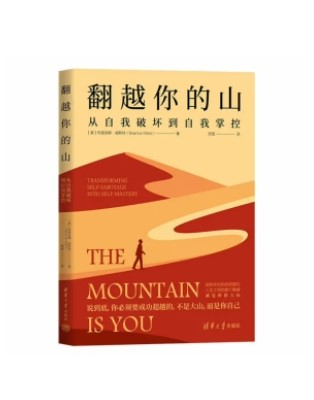
4
2024 has been a busy year, with daily work bringing different difficulties and challenges. From this book, I learned some methods for shifting from self-sabotage to self-mastery, and I hope to complete new work tasks in 2025 with a better mindset and approach:
Recognizing Self-Sabotage: Self-sabotaging behaviors may stem from childhood experiences, family environment, social pressures, etc., and can have a negative impact on personal behavior and decision-making. Regular self-reflection helps identify my own self-sabotaging behaviors and patterns.
Building a Positive Mindset: Changing how we perceive and approach challenges, learning to cultivate a positive mindset, and affirming ourselves with positive statements every day can help transform our view of difficulties.
Setting Goals and Cultivating Discipline: Clarifying both short-term and long-term goals, and creating a plan to achieve them, helps develop disciplined habits and manage time effectively. Tools such as to-do lists, prioritization, and time-blocking help avoid procrastination, while setting deadlines for tasks ensures progress.
Emotional Management and Interpersonal Relationships: Learning to identify and manage negative emotions, and developing effective communication and emotional regulation skills, can help achieve greater self-control in relationships.
Continuous Learning and Growth: Keeping an open mind, being willing to try new things, and constantly challenging oneself are key to achieving higher goals.
Facing Inner Challenges: This is what the company often refers to as "self-revolution." When facing internal challenges, it’s important to learn how to confront and overcome them, making thorough and lasting changes.
5
The barrier standing between you and the life you want is your "mountain."
Having gone through various experiences, every sentence in this book resonates deeply. From self-sabotage to self-mastery, the book offers healing paths. We often fall into self-denial when we don’t get the results we want, and we’re trapped by negative emotions such as self-doubt, fear, procrastination, and anxiety. What we don’t realize is that only by confronting our fears and clearing the accumulated emotions can we begin to shape a stronger version of ourselves.
It’s never as simple as just saying it: Let go of the past to build a new future. After overcoming one mountain after another, we come to realize that they ultimately become the landscape behind us. The person we become through the process of climbing is the most precious treasure.
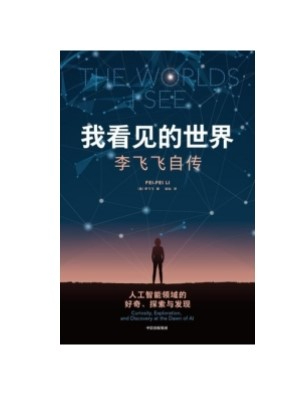
6
I recently read a book provided by the company, The World I See by Fei-Fei Li, a renowned AI scientist, often referred to as the "Mother of AI." Born in China, Fei-Fei moved to the United States at the age of 15. Her journey has been filled with hardships, yet her achievements are abundant. When it comes to family education, I believe there are three key takeaways:
Good Family Guidance Is Crucial: Fei-Fei Li greatly admires her engineer father, both in terms of his professional skills and his character. The book says, “If a child can design their ideal parents in the absence of adult supervision, then my father would absolutely meet my criteria.” Her father loved to focus on nature and life’s details, had a deep understanding of the way things are, and especially enjoyed taking Fei-Fei on adventures. He was an important guide in shaping how she sees the world.
Cultivating a Reading Habit Is Essential: Influenced by her family, Fei-Fei developed a love for reading from a young age. During middle school, her reading breadth far exceeded that of her classmates. Reading built her strong inner core, and even while working in a restaurant abroad, she continued reading classical literature.
Developing Independent Personality Is Key: In Fei-Fei’s family, important matters were discussed democratically, and her parents respected her opinions and encouraged her to try new things. During her time in the U.S., Fei-Fei became the “ideal child”—studying hard, earning money, and remaining true to herself. Ultimately, she became a key figure in shaping the future of human science.
7
After reading The World I See, I was deeply moved.
This book is like a grand painting unfolding before you, reflecting the author’s rich life experiences, and giving me a deeper understanding of dreams, perseverance, and the power of science. The author’s growth path wasn’t smooth—she faced numerous trials, challenges, and difficulties. From growing up in a poor family and constantly pursuing hope for a better life, to overcoming countless obstacles on her journey to scientific research, every challenge could have made most people give up. However, the author broke through her own limitations time and time again, emerging stronger each time, courageously pursuing her dreams. Her story teaches us that challenges and adversity are part of life, and overcoming these hardships, seeking our own paths, and realizing our life’s value is what truly matters.
What impressed me the most was Fei-Fei Li’s pure passion and reverence for science. She continuously explores the vast ocean of science, opening new fields, and unlocking doors to the future of technology for humanity. Her selflessness and relentless pursuit of knowledge have inspired us to crave knowledge and challenge the unknown.
The World I See is not just a book; it’s a revelation about dreams, struggle, and life. It teaches us that no matter how hard life is, we must have the courage to pursue the light in our hearts. No matter how complicated the world is, we must raise the flag of exploration and continue moving forward. The book tells us that on the road of life, we must courageously challenge ourselves, steadfastly pursue our dreams, use our eyes to see the colorful world, and measure our own life paths with our steps.
8
After finishing The World I See, I was truly moved and inspired.
This book not only tells the growth journey of Chinese-American scientist Fei-Fei Li, but also reveals the latest developments in artificial intelligence. The world of scientists often seems mysterious to ordinary people. When we truly get a glimpse into their world, we realize that they are also ordinary individuals with immense courage. Even top-tier researchers have to face challenges such as insufficient funding, long-distance marriages, constant worry about the health of their loved ones, and various other obstacles.
While the world of scientists may seem distant and out of reach, we can still gain valuable insights from Fei-Fei’s memoir. Curiosity, pragmatism, persistence, and purity—these qualities of a scientist—are essential traits for us to embrace in our own work as we courageously face challenges.
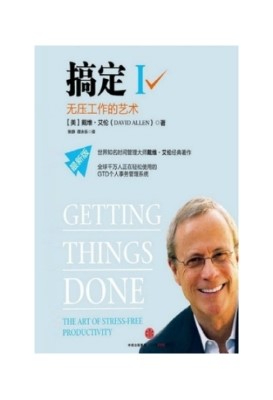
9
Getting Things Done: The Art of Stress-Free Productivity reveals how to achieve an efficient, stress-free work state through three parts.
1. The Path to Calmness
Our brains shouldn’t be used to store to-do lists; they should be used for thinking and creating. To achieve this, we need to record all tasks and ideas and transfer them to a reliable external system. This allows us to clear our minds, reduce anxiety and stress, and focus on the work at hand.
2. Away from Stress, Towards Efficiency
David Allen proposes the "Two-Minute Rule"—if a task can be completed in two minutes or less, we should do it immediately.
Additionally, Allen emphasizes the importance of a “context list.” A context list categorizes tasks based on the environment in which they need to be done, such as "Email," "Computer," or "Outdoors." This classification allows me to quickly select the most suitable task based on my current environment and conditions.
3. The Three Key Principles
Collecting is the first and most crucial step in the GTD method. We need to collect all tasks, ideas, and projects into a reliable system to ensure nothing important is missed. This process is not only about recording, but also about acknowledging and accepting our responsibilities. By removing these items from our minds, we reduce anxiety and stress, knowing we have a system we can rely on.
Processing is the decision-making stage in GTD. We need to quickly assess each task, decide the next steps, and determine if it requires immediate attention. This process has taught me how to quickly categorize tasks and prioritize them, instead of letting them pile up and create confusion and stress.
Reviewing is key to maintaining the effectiveness of the GTD method. Regularly reviewing the system ensures our action plans are up-to-date, our goals are clear, and our tasks are organized. This routine review allows me to adjust my work focus and ensures I'm on the right track.
4. Integrated Practice
By combining these three parts, we create a comprehensive GTD practice guide. First, we clear our minds by collecting all tasks and ideas to reduce cognitive load. Next, we process the tasks and decide the next action for each one, performing them based on the context list. Finally, we regularly review our system to ensure that our action plans and goals are current and that our tasks are well-organized.
10
At work, we often use forms and checklists, which immediately clarify our thinking once established. This book teaches us the scientific way to create checklists, establishing a complete, leak-proof organizational system to free our brains from low-level thinking.
By creating effective checklists, starting with basic categories, and finding specific relationships between unfinished tasks, we can organize and categorize these tasks. By adding creative and constructive prompts, the checklists help me focus on projects, workflows, procedures, events, hobbies, and potential issues.
Checklists allow us to approach tasks with clearer thinking, remain calm when solving problems, and achieve more with less effort. I believe that efficient work is extremely valuable for both individuals and companies.
11
I’ve only been with the company for a little over two months, and when I received my first book in November, I was surprised by the company culture. Getting Things Done I had the most profound impact on me. Learning the GTD time management method from the book was a deep and enlightening experience. Not only did the book provide me with a new way to manage my time and tasks, but it also led me to reevaluate my approach to work and life.
The book's “Natural Planning Model” has been especially helpful. It teaches me to clear tasks from my mind by recording them on paper or digital tools, then categorizing and prioritizing them based on urgency and importance. This method allows me to clearly see the tasks I need to complete, avoiding omissions and procrastination. It also teaches me how to set reasonable goals and break down large tasks into smaller steps, improving efficiency and completion rates. While I still sometimes face situations where tasks pile up and I don’t know how to deal with them, I no longer feel as anxious. I can now calmly address one task at a time, though I still need to work on overcoming my procrastination habits and improving my work efficiency.
Getting Things Done I not only provided me with a highly efficient time management and task handling method but also taught me how to better plan my life and work. In the future, I will continue to apply these principles and methods, constantly improving my skills and capabilities to create more value for my work and life.
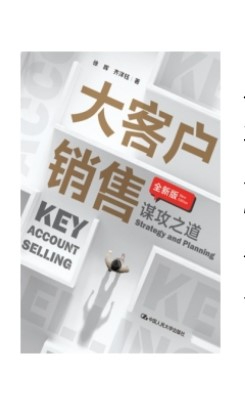
12
After thoroughly studying Key Account Sales: The Art of Strategy, I deeply realized that key account sales is not only a contest of skills and strategies but also a collision of wisdom and insight. Through rich real-world case studies, the book elaborates on how to accurately capture customer needs in a complex and ever-changing market environment, and how to devise and implement effective sales strategies.
What is described in the book is not just sales techniques but a way of thinking. It teaches me to be more forward-thinking when dealing with customers, not only providing high-quality products and services but also paying attention to their psychological needs. One should be able to view the bigger picture, formulate long-term plans, focus on details, and precisely address every customer need. By touching them with sincerity, we build deep trust and earn their confidence through professionalism and authenticity. Only by doing so can we stand out in the fierce market competition and achieve genuine win-win outcomes.
13
The three key elements of key account sales: People, Value, Process.
People refer to relationships. It is necessary to clarify the relationship between the demand department, the evaluation department, and the implementation department. One also needs to understand the thoughts of the final decision-maker, and find the right person through the right channels.
Value refers to making sure our products meet customer needs and helping the customer recognize the differentiating advantages of our products, leading them to choose us over others.
Process refers to understanding the rules, following them, and leveraging them effectively.
In summary, in key account sales, finding the right people, doing the right things, and hitting the right points will enable us to stay ahead and succeed.
Every archiving and summary marks the beginning of something new! That’s all for my reading reflections in 2024. See you in 2025!